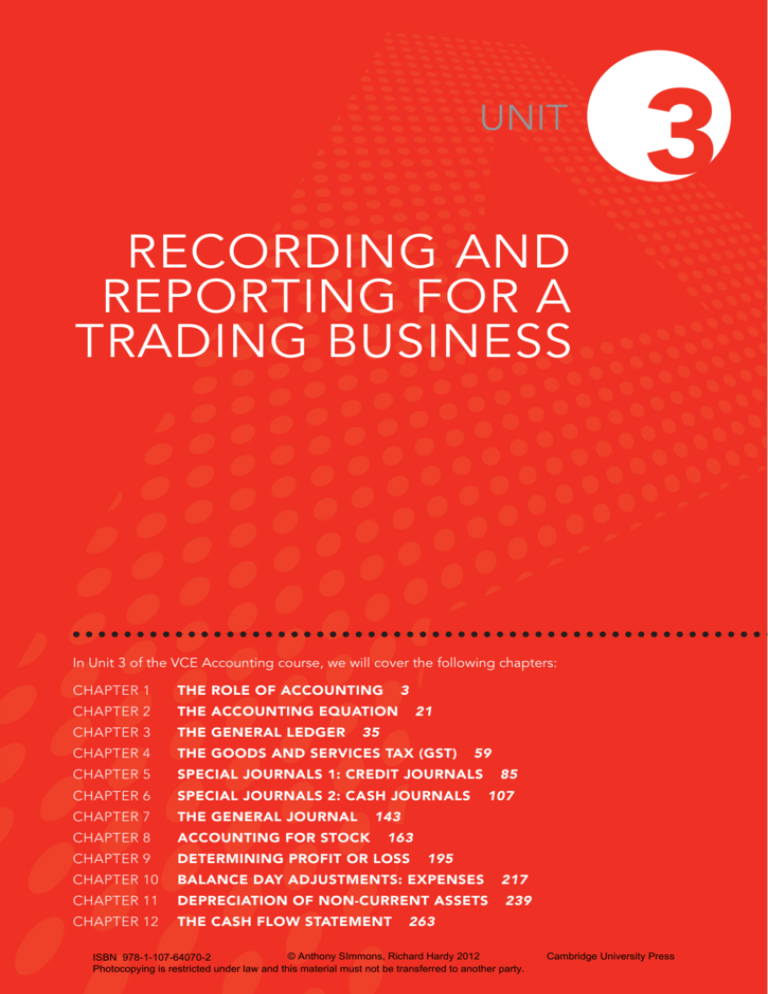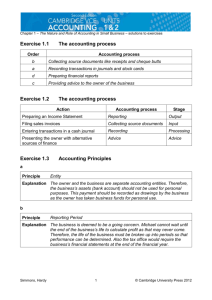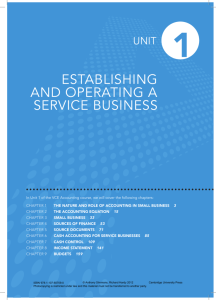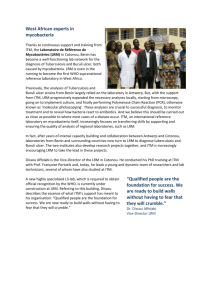Chapter 1: The role of accounting
advertisement

UNIT 3 RECORDING AND REPORTING FOR A TRADING BUSINESS In Unit 3 of the VCE Accounting course, we will cover the following chapters: 3 CHAPTER 1 THE ROLE OF ACCOUNTING CHAPTER 2 THE ACCOUNTING EQUATION CHAPTER 3 THE GENERAL LEDGER CHAPTER 4 THE GOODS AND SERVICES TAX (GST) CHAPTER 5 SPECIAL JOURNALS 1: CREDIT JOURNALS CHAPTER 6 SPECIAL JOURNALS 2: CASH JOURNALS CHAPTER 7 THE GENERAL JOURNAL CHAPTER 8 ACCOUNTING FOR STOCK CHAPTER 9 DETERMINING PROFIT OR LOSS CHAPTER 10 BALANCE DAY ADJUSTMENTS: EXPENSES 217 CHAPTER 11 DEPRECIATION OF NON-CURRENT ASSETS 239 CHAPTER 12 THE CASH FLOW STATEMENT 21 35 59 85 107 143 163 195 263 © Anthony SImmons, Richard Hardy 2012 ISBN 978-1-107-64070-2 Photocopying is restricted under law and this material must not be transferred to another party. Cambridge University Press © Anthony SImmons, Richard Hardy 2012 ISBN 978-1-107-64070-2 Photocopying is restricted under law and this material must not be transferred to another party. Cambridge University Press Where are we headed? After completing this chapter, you should be able to: s EXPLAIN the role of accounting s IDENTIFY the users of accounting information and THEFINANCIALINFORMATIONTHEY MAYREQUIRE s DISTINGUISH between financial data and financial information s IDENTIFY and EXPLAIN the stages in the accounting process s DEFINE and APPLY the accounting principles and QUALITATIVECHARACTERISTICS s EXPLAIN the relationships between the accounting PRINCIPLESANDQUALITATIVE characteristics s IDENTIFY and DEFINE the elements of financial statements. CHAPTER 1 THE ROLE OF ACCOUNTING KEY TERMS After completing this chapter, you should be familiar with the following terms: s elements of s accounting principles s financial data financial statements n ENTITY s financial information s transaction – Going Concern – assets s source documents – Reporting Period – liabilities s recording – Historical Cost n OWNERSEQUITY s reporting – Conservatism – revenue s advice n #ONSISTENCY – expense s agreed value n -ONETARY5NIT s MATERIALITY s QUALITATIVECHARACTERISTICS – Relevance n 2ELIABILITY n #OMPARABILITY n 5NDERSTANDABILITY © Anthony SImmons, Richard Hardy 2012 ISBN 978-1-107-64070-2 Photocopying is restricted under law and this material must not be transferred to another party. Cambridge University Press 4 CAMBRIDGE VCE ACCOUNTING 1.1 UNITS 3&4 THE PURPOSE OF ACCOUNTING 5NFORTUNATELY FOR BUSINESS OWNERS HAVING A GREAT BUSINESS IDEA IS NOT ENOUGH TO GUARANTEESUCCESS9OUDONTHAVETOLOOKVERYFARTOlNDSTORIESOFBUSINESSOWNERS WHOSTARTEDOUTWITHWHATTHEYTHOUGHTWASAFANTASTICPRODUCTORSERVICEBUTENDED UPGOINGBUST!SIDEFROMTHEQUALITYOFWHATBUSINESSOWNERSARESELLINGTHEREAREA VARIETYOFOTHERFACTORSTHATWILLINmUENCETHEIRCHANCEOFSUCCESSINCLUDING s CONSUMERTASTESANDDEMAND s THELEVELOFCOMPETITION s THEQUALITYOFTHEIRSTAFFEMPLOYEES s THEECONOMICCLIMATE s THEMANAGEMENTSKILLSOFTHEOWNERS 4HISLASTPOINTISPARTICULARLYIMPORTANTBECAUSEINMOSTSMALLBUSINESSESOWNERSHAVEA HANDSONMANAGERIALROLEANDTHEIRMANAGEMENTSKILLSCANHAVEADIRECTANDSIGNIlCANT EFFECTONWHATHAPPENSTOTHATBUSINESS7HETHERTHEYAREDETERMININGSELLINGPRICES DECIDING ON ADVERTISING CAMPAIGNS EMPLOYING STAFF OR UNDERTAKING MORE MUNDANE TASKSSUCHASPAYINGBILLSTHEOWNERMUSTMAKEIMPORTANTDECISIONSONADAILYBASIS #ERTAINLYSMALLBUSINESSOWNERSMUSTHAVEDETAILEDKNOWLEDGEOFWHATEVERITISTHEY ARETRYINGTOSELLBUTTHEYMUSTALSOHAVEDETAILEDINFORMATIONONAWHOLERANGEOFOTHER ISSUESTHATMAYAFFECTTHEIRCHANCESOFSUCCESS4HISISWHEREACCOUNTINGCOMESINTOTHE PICTUREITISESSENTIALLYANINFORMATIONSERVICE Accounting is the collection and recording of financial data, and the reporting, analysis and interpretation of financial information. purpose of accounting to provide financial information to assist decision-making The purpose of accountingISTOPROVIDEBUSINESSOWNERSWITHlNANCIALINFORMATION THATWILLASSISTTHEMINMAKINGDECISIONSABOUTTHEACTIVITIESOFTHEIRlRM4HISDOESNOT mean that accounting will ensure owners make the right decisions, but it should help them to make more informedDECISIONSWHICHWILLHOPEFULLYIMPROVETHEPERFORMANCE OFTHElRMANDITSCHANCESOFSUCCESS The purpose of accounting is to provide business owners with financial information that will assist them in making decisions about the activities of their firm © Anthony SImmons, Richard Hardy 2012 ISBN 978-1-107-64070-2 Photocopying is restricted under law and this material must not be transferred to another party. Cambridge University Press CHAPTER 1 5 THE ROLE OF ACCOUNTING 2%6)%715%34)/.3 1 ,ISTlVEFACTORSTHATCANINmUENCETHELIKELIHOODTHATASMALLBUSINESSWILLBE successful. 2 ,IST three important decisions that a business owner would need to make on ADAILYBASIS 3 $ElNE ‘accounting’. 4 %XPLAIN the purpose of accounting. 1.2 USERS OF ACCOUNTING INFORMATION 4HIS COURSE CONCENTRATES SPECIlCALLY ON ACCOUNTING FOR SOLE TRADERS THAT IS TRADING BUSINESSESTHATAREOWNEDBYONLYONEPERSONWHOISUSUALLYRESPONSIBLEFORRUNNING THE lRM &OR THIS REASON WE WILL CONCENTRATE ON THE INFORMATION THAT THE owner will WANTTOSEE(OWEVERITISIMPORTANTTONOTETHATANUMBEROFDIFFERENTPARTIESMAYBE INTERESTEDINTHElRMSlNANCIALINFORMATION4HESEPARTIESAREKNOWNASTHE@USERSOF THEACCOUNTINGINFORMATIONANDMAYINCLUDE s debtors and other customersWHOMAYWISHTOKNOWABOUTTHElRMSCONTINUING ABILITYTOPROVIDETHEMWITHSTOCK s creditors and other suppliersWHOMAYWISHTOKNOWABOUTTHElRMSABILITYTO REPAYWHATITOWESTHEM s banks and other financial institutionsWHOWILLWANTTOKNOWABOUTTHElRMS CURRENTLEVELSOFDEBTBEFOREPROVIDINGITWITHANYADDITIONALlNANCE s employeesWHOMAYWISHTOKNOWABOUTTHElRMSLONGTERMVIABILITYnANDTHEIR LONGTERMEMPLOYMENTPROSPECTSnORITSABILITYTOAFFORDIMPROVEMENTSINWAGES and conditions s prospective ownersWHOMAYWISHTOKNOWABOUTTHElRMSlNANCIALSTRUCTURE and earnings performance s the Australian Tax Office (ATO)WHICHWILLREQUIRElNANCIALINFORMATIONFORTAXATION purposes. #ONSIDERING THE VARIETY OF USERS OF ACCOUNTING INFORMATION AND THE DIFFERENT INFORMATIONEACHMAYREQUIREWHATINFORMATIONSHOULDTHEACCOUNTINGSYSTEMPROVIDE 4HISSEEMINGLYDIFlCULTQUESTIONHASASURPRISINGLYSIMPLYANSWERTHEACCOUNTINGSYSTEM SHOULDPROVIDEWHATEVERINFORMATIONTHEUSERDECIDESISNECESSARY4HISMEANSTHATITIS the usernNOTTHEACCOUNTANTORTHEACCOUNTINGSYSTEMnWHODECIDESWHATISNECESSARY Financial data versus financial information Given that accounting is concerned with providing information, it is worth noting the DIFFERENCEBETWEENlNANCIALdataANDlNANCIALinformation. Financial data refers to the RAWFACTSANDlGURESONWHICHlNANCIALINFORMATIONWILLBEBASED&ORMOSTBUSINESSES THIS DATA IS CONTAINED IN THEIR RECEIPTS CHEQUE BUTTS INVOICES AND OTHER BUSINESS DOCUMENTS&ORINSTANCEAlLEFULLOFBUSINESSDOCUMENTSMAYPROVIDETHEDETAILSDATA RELATINGTOTHElRMSACTIVITIESOVERTHELASTWEEKORMONTH However, in their original form these documents would be of limited use as the data HASNOTBEENPROCESSEDINANYWAY/NLYWHENTHISINFORMATIONISSORTEDCLASSIlEDAND summarised into a more useable and understandable form does it become financial informationTHATCANBEUSEDASTHEBASISFORBUSINESSDECISIONS4HISSORTINGCLASSIFYING ANDSUMMARISINGISPERFORMEDBYTHEACCOUNTINGSYSTEM © Anthony SImmons, Richard Hardy 2012 ISBN 978-1-107-64070-2 Photocopying is restricted under law and this material must not be transferred to another party. financial data raw facts and figures upon which financial information is based lNANCIALINFORMATION financial data that has been sorted, classified and summarised into a more useable and understandable form Cambridge University Press 6 CAMBRIDGE VCE ACCOUNTING UNITS 3&4 2%6)%715%34)/.3 1 ,ISTSIXLIKELYUSERSOFACCOUNTINGINFORMATION 2 %XPLAINWHYBANKSANDOTHERlNANCIALINSTITUTIONSWILLBEINTERESTEDINTHE lNANCIALINFORMATIONOFASMALLBUSINESS 3 %XPLAINTHEDIFFERENCEBETWEEN@lNANCIALDATAAND@lNANCIALINFORMATION 1.3 THE ACCOUNTING PROCESS If we work backwards, then what the owner is looking for is the information the ACCOUNTINGSYSTEMCANPROVIDE$ATAMUSTBECOLLECTEDPROCESSEDINTOAUSEABLEFORM and then communicated so that the business owner has meaningful information on which to base a decision. The accountant should then provide some guidance as to appropriate courses of action. These four ‘phases’ or ‘stages’ are the basis of what is known as the accounting process. Figure 1.1 The accounting process Sources documents Records Reports Provides advice Stage 1: collecting source documents TRANSACTION an exchange of goods or services with another party SOURCEDOCUMENTS paper or electronic documents that provide both the evidence that a transaction has occurred and the details of the transaction itself Collecting source documents is sometimes known as the ‘input stage’, where the business collects the source documents relating to its transactions. A transaction is SIMPLYANEXCHANGEOFGOODSORSERVICESWITHANOTHERPARTY Source documents are the paper or electronic documents that provide both the evidence that a transaction has occurred and the details of the transaction itself. Source documents provide the data on which the accounting information will be based. Common source documents include: s receiptsWHICHPROVIDEEVIDENCEOFCASHRECEIVEDBYTHEBUSINESS s cheque buttsWHICHPROVIDEEVIDENCEOFCASHPAIDBYTHEBUSINESS s invoices, which provide evidence of credit sales and purchases s memosWHICHPROVIDEEVIDENCEOFTRANSACTIONSWITHINTHElRMITSELF These source documents are covered in more detail in Chapter 4. ! BUSINESS WILL ENTER INTO MANY TRANSACTIONS EVERY DAY AND EVERY ONE OF THESE transactions must be detailed on a source document. As far as the accounting process is concerned, if it isn’t written down, it didn’t happen. Stage 2: recording recording sorting, classifying and summarising the data contained in the source documents so that it is more useable /NCETHESOURCEDOCUMENTSHAVEBEENCOLLECTEDTHEDATATHEYCONTAINMUSTBEWRITTEN down or noted in a more useable form, or ‘recorded’. Recording involves sorting, CLASSIFYINGANDSUMMARISINGTHEDATACONTAINEDINTHESOURCEDOCUMENTSSOTHATITIS more useable. This is sometimes known as the ‘processing’ stage, where data becomes information. Common accounting records include: s journalsWHICHRECORDDAILYTRANSACTIONSOFACOMMONTYPESUCHASALLCASHPAIDOR ALLSTOCKPURCHASEDONCREDIT s ledgersWHICHRECORDTHEEFFECTOFEACHTRANSACTIONONTHEITEMSINTHElRMS accounting reports s stock cards, which record all the movements of stock in and out of the business. © Anthony SImmons, Richard Hardy 2012 ISBN 978-1-107-64070-2 Photocopying is restricted under law and this material must not be transferred to another party. Cambridge University Press CHAPTER 1 7 THE ROLE OF ACCOUNTING 4HESEACCOUNTINGRECORDSANDHOWTHEYAREUSEDWILLBEDISCUSSEDINDETAILTHROUGHOUT this text. Stage 3: reporting The ‘output’ stage of the accounting process involves taking the information generated BYTHEACCOUNTINGRECORDSINSTAGEANDREPORTINGTHATlNANCIALINFORMATIONTOTHE owner of the business in an understandable form. Reporting involves the preparation OF lNANCIAL STATEMENTS THAT COMMUNICATE lNANCIAL INFORMATION TO THE OWNER SO THAT decisions can be made. There are three general-purpose reports that all businesses should prepare: s a Cash Flow StatementWHICHREPORTSONTHElRMSCASHINmOWSANDOUTmOWSAND the change in its cash balance over a period s an Income StatementWHICHREPORTSONTHElRMSABILITYTOEARNAPROlTFROMITS trading activities over a period s a Balance SheetWHICHREPORTSONTHElRMSASSETSANDLIABILITIESATAPARTICULAR point in time. reporting the preparation of financial statements that communicate financial information to the owner Stage 4: advice Armed with the information presented in the reports, the owner should be in a much better position to make informed decisions. However, the best course of action is sometimes unclear. Therefore, the accountant should be able to offer advice BYMAKING SOMESUGGESTIONSABOUTANAPPROPRIATECOURSEOFACTIONORATTHEVERYLEASTPRESENTING OWNERSWITHARANGEOFOPTIONSFROMWHICHTHEYCANTHENCHOOSE 4HEPROVISIONOFADVICEISTHEACCOUNTANTSKEYFUNCTIONBUTTHISADVICERESTSONTHE INFORMATIONGENERATEDBYTHElRSTTHREESTAGESOFTHEACCOUNTINGPROCESS %SSENTIALLYTHEACCOUNTINGPROCESSINVOLVESCOLLECTINGDATAFROMSOURCEDOCUMENTS SORTINGITCLASSIFYINGITANDWRITINGITDOWNCOMMUNICATINGTHElNANCIALINFORMATIONTO the owner; and providing advice about that information. We will refer to this accounting PROCESSTHROUGHOUTTHETEXTSOTHATYOUHAVEACLEARIDEAOFHOWEACHTOPIClTSINTO the overall process. advice the provision to the owners of a range of options appropriate to their aims/objectives, together with recommendations as to the suitability of those aims/objectives 2%6)%715%34)/.3 1 ,ISTthe four stages in the accounting process. 2 %XPLAINthe role of source documents in the accounting process. 3 3TATETHETYPEOFTRANSACTIONEVIDENCEDBYTHEFOLLOWINGSOURCEDOCUMENTS CUMENTS s receipt s CHEQUEBUTT s invoice s memo. 4 %XPLAINthe difference between the ‘recording’ and ‘reporting’ stages of the accounting process. 5 3TATEthe purpose of the following accounting reports: s Cash Flow Statement s Income Statement s Balance Sheet. © Anthony SImmons, Richard Hardy 2012 ISBN 978-1-107-64070-2 Photocopying is restricted under law and this material must not be transferred to another party. Cambridge University Press 8 CAMBRIDGE VCE ACCOUNTING 1.4 accounting principles the generally accepted rules that govern the way accounting information is generated UNITS 3&4 ACCOUNTING PRINCIPLES "YANDLARGEACCOUNTANTSAPPROACHTHEIRCRAFTFROMACOMMONPERSPECTIVE&ORINSTANCE MOSTWOULDAGREETHATAMOTORVEHICLEOWNEDBYTHElRMSHOULDBEREGARDEDASANASSET However, from time to time certain issues arise where proper accounting procedure is unclear, and a number of alternative approaches are possible. For instance, if a business PURCHASEDABUILDINGINFORANDSPENTONRENOVATIONSIN ATWHATVALUESHOULDITBERECORDEDANDREPORTEDTODAY7HATIFTHEBUILDINGWOULD BEWORTHIFSOLDTODAY7HATIFITSPLUMBINGSYSTEMREQUIRESREPLACEMENT )NSHORTHOWMUCHISTHEBUILDINGWORTH 4HESEAREBUTAFEWOFTHEQUESTIONSTHATANACCOUNTANTMUSTANSWERANDINMANY CASESEACHOFTHESEQUESTIONSCOULDHAVEMORETHANONEANSWER 4O PROVIDE FOR SOME DEGREE OF CERTAINTY THE ACCOUNTING PROFESSION HAS AGREED to a number of accounting principles THAT GOVERN THE WAY ACCOUNTING INFORMATION IS generated. In this course, we will investigate the following accounting principles: s ENTITY s 'OING#ONCERN s 2EPORTING0ERIOD s (ISTORICAL#OST s #ONSERVATISM s #ONSISTENCY s -ONETARY5NIT Entity Entity the business is assumed to be separate from the owner and other businesses, and its records should be kept on this basis The Entity principle states that from an accounting perspective, the business is assumed to be separate from the owner and other businesses, and its records should be kept on THISBASIS4HISMAYSEEMASLIGHTLYBIZARREIDEAESPECIALLYWHENWECONSIDERTHATTHE OWNEROFASOLEPROPRIETORSHIPISFREQUENTLYTHEPERSONBEHINDTHECOUNTERORTHEONE ACTUALLYPERFORMINGTHESERVICE(OWEVERIFWEARETOASSESSTHEPERFORMANCEOFTHE business itselfWEMUSTINCLUDEONLYINFORMATIONRELEVANTTOTHATBUSINESS4HEOWNER MAYHAVEABEACHHOUSEORAFOURWHEELDRIVEBUTIFTHISITEMISNOTBEINGUSEDBYTHE business, it must not be included as a business asset. Transactions between the business and the owner )NPRACTICALTERMSTHE%NTITYPRINCIPLEMEANSTHATTHEBUSINESSMUSTHAVEASEPARATE BANKACCOUNTANDTHATITSHOULDONLYBEUSEDFORBUSINESSPURPOSES)FTHEOWNERUSES the business’s funds for personal purposes, this must be recorded in the business’s records as drawings. )NTHESAMEWAYIFTHEOWNERCONTRIBUTESPERSONALASSETSTOTHEBUSINESSTHENTHIS SHOULD BE RECORDED AS A CAPITAL CONTRIBUTION FROM ONE ENTITY THAT IS THE OWNER TO ANOTHERENTITYTHATISTHEBUSINESS )NTHECASEOFACONTRIBUTIONOFNONCASHASSETSSUCHASAVEHICLETHE%NTITYPRINCIPLE WILLHAVEAFURTHEREFFECTINTERMSOFTHEWAYTHEASSETISVALUED#ONSIDERANASSETSUCH ASAVEHICLEPURCHASEDBYTHEOWNERBUTTHENCONTRIBUTEDTOTHEBUSINESS4HISASSET CANNOTBEVALUEDATTHEORIGINALPRICEPAIDBYTHEowner, as it is the cost to the business, ASASEPARATEENTITYTHATISIMPORTANT However, although the business and the owner are assumed to be separate ACCOUNTING ENTITIES THERE WOULD BE NO SOURCE DOCUMENT TO VERIFY THE @SALE BY THE OWNER TO THE BUSINESS AS THEY ARE IN FACT ONE AND THE SAME )N THIS CASE THE ASSET © Anthony SImmons, Richard Hardy 2012 ISBN 978-1-107-64070-2 Photocopying is restricted under law and this material must not be transferred to another party. Cambridge University Press CHAPTER 1 9 THE ROLE OF ACCOUNTING If a business owner contributes a personal asset, such as a vehicle, to the business, this should be recorded as a capital contribution from one Entity (the owner) to another Entity (the business) would be recorded in the books of the business at an agreed value DETERMINEDATTHE TIMETHEASSETISCONTRIBUTEDTOTHEBUSINESS4HISAGREEDVALUEWOULDTHENBECOMETHE effective Historical Cost as far as the business is concerned. Going Concern The Going Concern principle assumes that the life of the business is continuous, and its records are kept on that basis. This principle is important because it allows us to record transactions that have an effect on the future. For instance, where a sale is made on CREDITTERMSTHECASHWILLNOTHAVEBEENRECEIVEDFROMTHECUSTOMER"YASSUMINGTHAT THEBUSINESSWILLCONTINUETRADINGINDElNITELYTHE'OING#ONCERNPRINCIPLEALLOWSUSTO RECORDDEBTORSAMOUNTSOWEDTOTHEBUSINESSBYCREDITCUSTOMERSASANASSETBECAUSE ATSOMESTAGEINTHEFUTURETHEBUSINESSISLIKELYTORECEIVECASH4HESAMEAPPLIESTO amounts the business owes to its creditors for its credit purchases, or to amounts the BUSINESSHASPAIDINADVANCEFORBENElTSITISYETTORECEIVE 4HEEFFECTOFTHE'OING#ONCERNPRINCIPLEISALSOSIGNIlCANTINDISTINGUISHINGBETWEEN EXPENSESWHOSEBENElTISCONSUMEDENTIRELYANDASSETSWHOSEBENElTEXTENDSINTO THEFUTURE/NLYBYASSUMINGTHATTHELIFEOFTHEBUSINESSISONGOINGCANWERECOGNISE THEBENElTTHATwill beDERIVEDSOMETIMEINTHEFUTUREFROMTHEASSETSUNDERTHElRMS CONTROL3EE@4HEELEMENTSOFlNANCIALSTATEMENTSFORADISCUSSIONOFTHEDIFFERENCE BETWEENASSETSANDEXPENSES agreed value the accepted value of a non-cash asset at the time of its contribution by the owner Going Concern the life of the business is assumed to be continuous, and its records are kept on that basis Reporting Period The Reporting Period principle states that the life of the business must be divided into PERIODS OF TIME TO ALLOW REPORTS TO BE PREPARED 4HIS PRINCIPLE IS INEXTRICABLY LINKED to the idea that the business is a Going Concern. Because the life of the business is ASSUMEDTOBECONTINUOUSITISNECESSARYTODIVIDETHATLIFEINTOARBITRARYPERIODSSO THATPROlTCANBEDETERMINED7ECANNOTWAITUNTILTHEENDOFTHElRMSLIFETOCALCULATE PROlTBECAUSEWEAREASSUMINGTHATTHEENDWILLNEVERCOMESOWECALCULATEPROlTFOR THEMONTHORYEAR!2EPORTING0ERIODCANBEASSHORTASTHEOWNERREQUIRESBUTIN MOSTCASESTOMEETTAXATIONREQUIREMENTSISNOLONGERTHANAYEAR © Anthony SImmons, Richard Hardy 2012 ISBN 978-1-107-64070-2 Photocopying is restricted under law and this material must not be transferred to another party. Reporting period the life of the business must be divided into periods of time to allow reports to be prepared; these accounting reports should reflect the Reporting Period in which a transaction occurs Cambridge University Press CAMBRIDGE VCE ACCOUNTING accrual accounting calculating profit by comparing revenues earned against expenses incurred in a particular reporting period Historical Cost the recording of a transaction at its original cost or value, as this value is verifiable by reference to the source document UNITS 3&4 /NEPOSSIBLECONSEQUENCEOFDIVIDINGTHELIFEOFTHEBUSINESSISTHATATTHEENDOFA 2EPORTING0ERIODTHEBUSINESSMAYSTILLBEWAITINGFORSOMECASHFROMDEBTORSORMAY NOTYETHAVEPAIDFORSOMEEXPENSES4HESEAMOUNTSARESTILLINCLUDEDINTHECALCULATION OF PROlT AS THE REVENUE WAS earned WHEN THE GOODS WERE SOLD AND THE EXPENSE incurredWHENTHEITEMWASCONSUMEDINTHECURRENTREPORTINGPERIOD4HISMETHODOF CALCULATINGPROlTASREVENUESearned less expenses incurred in each Reporting Period is known as accrual accounting. Historical Cost The Historical Cost principle states that a transaction should be recorded at its original COSTORVALUEASTHISVALUEISVERIlABLEBYREFERENCETOTHESOURCEDOCUMENT4HISPRINCIPLE APPLIESPARTICULARLYTOASSETSWHICHMUSTBERECORDEDATTHEIRORIGINALPURCHASEPRICE !NYOTHERVALUATIONSUCHASRESALEVALUEORREPLACEMENTVALUEISSUBJECTTOACERTAIN amount of guesswork, and therefore Historical Cost is preferred. For instance, if land ISBOUGHTFORANDISLATERESTIMATEDTOBEWORTHITSHOULDREMAIN INTHEACCOUNTINGRECORDSASASTHEOTHERPRICEISONLYANESTIMATEANDNOT VERIlABLE4HEREARECERTAINSITUATIONSINWHICHITISACCEPTABLETOUSEAVALUATIONOTHER than Historical Cost, but these situations will be covered in later chapters. Conservatism Conservatism losses should be recorded when probable but gains should only be recorded when certain, so that liabilities and expenses are not understated and assets and revenues are not overstated The Conservatism principle states that losses should be recorded when probable but GAINS SHOULD BE RECORDED ONLY WHEN CERTAIN SO THAT LIABILITIES AND EXPENSES ARE NOT understated and assets and revenues are not overstated. This principle advocates a worst-case scenario approach to accounting. Where different valuations are possible, or it is impossible to avoid the use of an estimate, accountants should use whichever data gives the most cautious or ‘conservative’ assessment. This does not mean the records SHOULDDELIBERATELYREPRESENTASITUATIONASWORSETHANITACTUALLYISBUTITDOESMEAN THEY SHOULD NOT REPRESENT THE SITUATION AS BETTER THAN IT MIGHT TURN OUT TO BE &ROM AN ACCOUNTING POINT OF VIEW IT IS BETTER TO BE CAUTIOUS AND CONSERVATIVE THAN OVERLY OPTIMISTICANDTHENGETARUDESHOCKWHENREALITYDOESNOTMATCHEXPECTATIONS Consistency Consistency accounting methods should be applied in a consistent manner to ensure that reports are comparable between periods The Consistency principles states that accounting methods should be applied in a consistent manner from one period to the next, so that reports can be compared BETWEENPERIODS7ITHOUTCONSISTENTACCOUNTINGMETHODSITISDIFlCULTTOTELLWHETHER changes in accounting reports are the result of changes in business performance, or SIMPLY CHANGES IN ACCOUNTING PROCEDURES 4HIS MAKES IT DIFlCULT TO COMPARE REPORTS from one period to the next. The amounts in the reports do not need to be the same, BUTTHEWAYTHEYARECALCULATEDDOES Monetary Unit Monetary Unit all items must be recorded and reported in a common unit of measurement; that is, Australian dollars The Monetary Unit principle states that all items must be recorded and reported in a common unit of measurement; that is, Australian dollars. This is one of the more obvious principles. It would make little sense to record the purchase of a motor vehicle as ‘1 Holden Commodore’ without attaching a valuation in dollars. To do so would make it impossible to aggregate total assets or make comparisons between periods ORBUSINESSES3IMILARLYRECORDINGLOANSIN!USTRALIANDOLLARSANDSTOCKIN*APANESEYEN would make the information impossible to use. © Anthony SImmons, Richard Hardy 2012 ISBN 978-1-107-64070-2 Photocopying is restricted under law and this material must not be transferred to another party. Cambridge University Press CHAPTER 1 THE ROLE OF ACCOUNTING The Monetary Unit principle states that all items must be recorded and reported in a common unit of measurement; that is, Australian dollars 2%6)%715%34)/.3 1 $ElNE the following accounting principles: s ENTITY s Going Concern s Reporting Period s Historical Cost s Conservatism s #ONSISTENCY s -ONETARY5NIT 2 %XPLAINONEPRACTICALCONSEQUENCEOFADOPTINGTHEENTITYPRINCIPLE 3 3TATETHELENGTHOFA2EPORTING0ERIOD"EWARETHISISATRICKQUESTION 4 %XPLAINWHYTHEIMPLEMENTATIONOFTHE'OING#ONCERNPRINCIPLEREQUIRESTHE adoption of the Reporting Period principle. 5 3TATEHOWPROlTISCALCULATEDUNDERACCRUALACCOUNTING 1.5 QUALITATIVE CHARACTERISTICS In addition to the accounting principles, which guide the recording process, the profession IS GUIDED BY WHAT IS KNOWN AS The International Framework for the Preparation and Presentation of Financial Reports. The Framework, as it has become known, sets out the BROADCONCEPTSTHATUNDERPINTHEPREPARATIONOFlNANCIALREPORTS4HESECONCEPTSARE known as qualitative characteristics4HE&RAMEWORKALSODElNESTHEITEMSTHATWILLBE reported in each report. The Framework also provides the basis for the development of Accounting Standards, WHICH ARE RULES GOVERNING SPECIlC ACCOUNTING PROCEDURES THAT ALL ACCOUNTANTS ARE COMPELLED TO FOLLOW 4HESE STANDARDS UNDERPIN MANY OF THE TECHNIQUES USED IN THIS TEXTBUTSTUDENTSARENOTREQUIREDTOKNOWTHERELEVANT!CCOUNTING3TANDARD If we follow and implement the accounting principles when we are recording, then OUR ACCOUNTING REPORTS SHOULD POSSESS THE QUALITATIVE CHARACTERISTICS OUTLINED IN THE &RAMEWORK4HEQUALITATIVECHARACTERISTICSAREBASICALLYTHEQUALITIESWEWOULDLIKEOUR ACCOUNTING INFORMATION TO POSSESS 4HE FOUR QUALITATIVE CHARACTERISTICS OF ACCOUNTING reports are: s 2ELEVANCE s 2ELIABILITY s #OMPARABILITY s 5NDERSTANDABILITY © Anthony SImmons, Richard Hardy 2012 ISBN 978-1-107-64070-2 Photocopying is restricted under law and this material must not be transferred to another party. qualitative characteristics the qualities of the information in accounting reports Cambridge University Press CAMBRIDGE VCE ACCOUNTING STUDY TIP Accounting principles APPLYMAINLYTORECORDS WHEREASQUALITATIVE CHARACTERISTICSAPPLYTO reports. Relevance accounting reports should include all information that is useful for decision-making materiality size or significance UNITS 3&4 Relevance Relevance states that reports should include all information that is useful for decisionmaking, and exclude information that is not. This information should be up-to-date, ANDAPPROPRIATETOTHEDECISIONATHAND4HEQUALITYOF2ELEVANCEGUIDESUSINWHAT TO INCLUDE IN OUR REPORTS AND WILL BE PRESENT IF WE FOLLOW THE %NTITY AND 2EPORTING Period principles. For example, when preparing a Balance Sheet for a business, it is not relevant to include the personal assets of the owner, as these are not being used BYTHEBUSINESSTOEARNREVENUEANDTHUSARENOTUSEFULFORMAKINGDECISIONSABOUT FUTUREBUSINESSACTIVITIES3IMILARLYTHE)NCOME3TATEMENTSHOULDINCLUDEONLYREVENUES ANDEXPENSESFROMTHECURRENT2EPORTING0ERIODnLASTYEARSWAGESORNEXTYEARSSALES lGURESWILLNOTHELPUSTOASSESSTHISYEARSPROlT4HEKEYISWHETHERTHEINFORMATIONIS useful for decision-making. !LTHOUGH2ELEVANCEISDETERMINEDLARGELYBYWHETHERTHEnature of the item makes it useful for decision-making, the size or materiality of the item can also be important. )TEMSTHATARETOOSMALLORINSIGNIlCANTTOAFFECTDECISIONMAKINGMAYBECONSIDEREDTO BEIMMATERIALMEANINGTHEYCANBEREPORTEDINTHEVALUEOFALARGERITEMORINSOME cases omitted from the reports. For instance, Relevance allows us to omit from the "ALANCE3HEETSPENTONSTATIONERYASITISSUCHASMALLAMOUNTANDINSTEADREPORT THISASANEXPENSE)TSINCLUSIONOREXCLUSIONFORTHATMATTERINTHE"ALANCE3HEETWILL NOTAFFECTDECISIONMAKINGINANYMATERIALWAY Reliability Reliability accounting reports should contain information that is accurate, and free from bias or error Reliability states that reports should contain information that is free from bias and ERRORANDTHUSCANBERELIEDUPONFORITSACCURACY4HEQUALITYOFReliability means that in relation to the amounts we show in reports, we should avoid the use of estimates. 2ELIABILITY WILL BE ASSISTED VIA THE (ISTORICAL #OST PRINCIPLE BECAUSE THE BEST WAY TO ENSURE THAT INFORMATION IS FREE FROM BIAS AND ERROR IS TO MAKE SURE IT IS VERIlABLE BY REFERENCETOASOURCEDOCUMENT2ELIABLEINFORMATIONHASPROOFTOSUPPORTITSACCURACY For example, it should be possible to check the level of credit sales reported in the Income Statement against the invoices that documented the sales. This ensures there is NOROOMFORSUBJECTIVITYORGUESSES Comparability Comparability accounting reports should be able to be compared over time Understandability accounting reports should be presented in a manner that makes it easy for them to be understood by the user Comparability states that reports should be comparable over time, and between different companies, through the use of consistent accounting procedures. One of the most basic uses of accounting reports is to compare performances of businesses and BETWEENPERIODS(OWEVERTHISWILLONLYBEPOSSIBLEIFCONSISTENTACCOUNTINGMETHODS have been used. Where accounting procedures are changed, this should be stated CLEARLYDISCLOSEDINTHEREPORTSSOTHATTHEUSERSCANMAKEMOREINFORMEDASSESSMENTS of what the reports are telling them. Understandability Understandability states that reports should be presented in a manner that is simple to understand. It is important to remember that the most basic function of accounting reports is to COMMUNICATEINFORMATIONTOTHEUSERTHATISSOLETRADERSANDOROWNERS-OSTSMALL business owners are not accountants, so it is not sensible to present reports in a form that owners cannot understand. The characteristic of 5NDERSTANDABILITYMEANSITISEASY FORTHEUSERTOCOMPREHENDTHEMEANINGOFREPORTS&ORTHISREASONITMAYBEMORE EFFECTIVETOPRESENTINFORMATIONINGRAPHSTABLESORCHARTSORSIMPLYINLANGUAGETHATIS FREEFROMACCOUNTINGJARGON © Anthony SImmons, Richard Hardy 2012 ISBN 978-1-107-64070-2 Photocopying is restricted under law and this material must not be transferred to another party. Cambridge University Press CHAPTER 1 THE ROLE OF ACCOUNTING )NSUMMARYTHEACCOUNTINGPROCESSISGUIDEDBY s ACCOUNTINGPRINCIPLESWHICHGOVERNTHEWAYACCOUNTINGINFORMATIONISRECORDED s QUALITATIVECHARACTERISTICSWHICHINFORMTHEWAYACCOUNTINGREPORTSAREPREPARED 2%6)%715%34)/.3 1 $ElNETHEFOLLOWINGQUALITATIVECHARACTERISTICS s 2ELEVANCE s 2ELIABILITY s #OMPARABILITY s 5NDERSTANDABILITY 2 %XPLAINHOWTHE%NTITYAND2EPORTING0ERIODPRINCIPLESENSURE2ELEVANCEIN the accounting reports. 3 2EFERRING TO ONE QUALITATIVE CHARACTERISTIC EXPLAIN WHY ACCOUNTANTS MUST follow the Historical Cost principle. 4 %XPLAIN HOW THE RECORDING SYSTEM CAN ENSURE Comparability of accounting reports. 5 3UGGESTTWOWAYSOFIMPROVINGTHE5NDERSTANDABILITY of accounting reports. 1.6 THE ELEMENTS OF FINANCIAL STATEMENTS 7EHAVEDISCUSSEDATLENGTHTHEQUALITIESTHATACCOUNTINGREPORTSSHOULDPOSSESSBUT WHATITEMSSHOULDTHEYINCLUDE4HE&RAMEWORKDElNESTHEELEMENTSOFTHEACCOUNTING reports as: s ASSETS s LIABILITIES s OWNERSEQUITY s REVENUES s EXPENSES Assets AssetsARERESOURCESCONTROLLEDBYANENTITYASARESULTOFPASTEVENTSFROMWHICHFUTURE ECONOMICBENElTSAREEXPECTEDTOmOWTOTHEENTITY&ORANITEMTOBERECOGNISEDAS ANASSETITMUSTMEETEACHPARTOFTHEDElNITION!NITEMTHATFAILSTOMEETANYOFTHESE REQUIREMENTSCANNOTBECONSIDEREDTOBEANASSET ,ETSBREAKTHISDElNITIONDOWNINTOITSMAINCOMPONENTS Resources controlled by the entity asset a resource controlled by an entity, as a result of past events, from which future economic benefits are expected to flow to the entity 2ESOURCES ARE SIMPLY ITEMS THAT ARE CAPABLE OF GENERATING AN ECONOMIC GAIN FOR A BUSINESSSUCHASBANKTHECASHHELDTHERENOTTHEBUILDINGDEBTORSSTOCKVEHICLES and premises. (OWEVERONLYTHOSEITEMSTHATAREUNDERTHElRMScontrolCANBEDElNEDASASSETS 4HISMEANSTHATTHElRMMUSTBEINAPOSITIONTODETERMINEHOWANDWHENTHEITEMIS used. For instance, it is up to the business to determine how and when the cash in the BANKACCOUNTWILLBESPENTWHENTHEDEBTORSAREEXPECTEDTOPAYANDHOWTHEVEHICLES will be used. "YCONTRASTTHEOWNERSHOMECANNOTBECLASSIlEDASAbusiness asset because it is not under business control$ONTFORGETTHE%NTITYPRINCIPLEHERETHEOWNERSHOMEIS UNDERTHECONTROLOFTHEOWNERWHOISCONSIDEREDTOBEASEPARATEACCOUNTINGENTITY from the business. © Anthony SImmons, Richard Hardy 2012 ISBN 978-1-107-64070-2 Photocopying is restricted under law and this material must not be transferred to another party. Cambridge University Press CAMBRIDGE VCE ACCOUNTING UNITS 3&4 .OTETHATALTHOUGHABUSINESSWILLOWNMANYOFITSASSETSOWNERSHIPITSELFISNOTA NECESSARY CONDITION FOR AN ITEM TO BE CLASSIlED AS A BUSINESS ASSET Control is much broader than ownershipSOTHElRMSASSETSWILLOBVIOUSLYINCLUDEBUTNOTBERESTRICTED to, what it owns. Future economic benefits In addition to falling under business control, assets must be capable of generating a futureECONOMICBENElT4HATISTHEYMUSTREPRESENTSOMESORTOFBENElTTHATISYETTO BERECEIVED4HISREmECTSTHE'OING#ONCERNPRINCIPLE&OREXAMPLECASHINTHEBANK can be spent and stock can be sold at some point in the future; the amount owed to THEBUSINESSBYITSDEBTORSWILLBERECEIVEDASCASHSOMETIMEINTHENEXTMONTHORSO ANDITEMSSUCHASPREMISESANDVEHICLESWILLUSUALLYBEUSEDFORBUSINESSACTIVITIESFORA NUMBEROFYEARSINTOTHEFUTURE On the other hand, cash paid for this month’s wages is not an asset, as there is no FUTUREBENElT)NORDERTOGAINAFURTHERBENElTFROMEMPLOYEESAFURTHERPAYMENTMUST BEMADE)TEMSSUCHASTHISCANNOTBECLASSIlEDASASSETSBECAUSETHEIRBENElTDOES NOTEXTENDBEYONDWHATHASALREADYBEENRECEIVED Liabilities liability a present obligation of the entity as a result of past events, the settlement of which is expected to result in an outflow from the entity of resources embodying economic benefits LiabilitiesAREPRESENTOBLIGATIONSOFTHEENTITYASARESULTOFPASTEVENTSTHESETTLEMENT OF WHICH IS EXPECTED TO RESULT IN AN OUTmOW FROM THE ENTITY OF RESOURCES EMBODYING ECONOMICBENElTS4HISMAYSEEMLIKEALOTOFJARGONBUTBROKENINTOITSCOMPONENTS it is easier to understand. Present obligations )FTHEBUSINESSHASALEGALRESPONSIBILITYORobligationTOSETTLEADEBTTHENTHISDEBTIS LIKELYTOBEALIABILITY)NTHECASEOFABANKOVERDRAFTORMORTGAGETHECONTRACTWITHTHE LENDERMEANSTHEBUSINESSISOBLIGEDTOREPAYTHEAMOUNTOWING #ONTRASTTHESEITEMSWITHTHEAMOUNTTHATTHEBUSINESSEXPECTSTOPAYNEXTYEARFOR ADVERTISING4HISCANNOTBEREPORTEDASALIABILITYASATPRESENTTHEREISNOOBLIGATION TO PAY 4HE OBLIGATION WILL ONLY OCCUR ONCE THE lRM HAS SIGNED THE CONTRACT OR THE advertising itself has been provided. Expected to result in an outflow of economic benefits 4HEFACTTHATALIABILITYISexpectedTORESULTINANOUTmOWORSACRIlCEOFECONOMICBENElTS MEANSTHATTHEOUTmOWSACRIlCEHASNOTYETOCCURRED)NTHISWAYALIABILITYCOULDBE SEENASREQUIRINGAfuture economic sacrifice. )NMOSTCASESTHEECONOMICBENElTTOBESACRIlCEDWILLBECASHANDTHEEXPECTED OUTmOWWILLOCCURWHENTHEBUSINESSPAYSITSDEBTS(OWEVERTHISISNOTALWAYSTHECASE THERE MAY BE AN ALTERNATIVE ECONOMIC BENElT THAT MUST BE SACRIlCED &OR EXAMPLE A lRM MAY HAVE RECEIVED CASH IN ADVANCE FOR A JOB YET TO BE COMPLETED IT IS NOT A PAYMENTTHATISREQUIREDTOEXTINGUISHTHISLIABILITYBUTTHECOMPLETIONOFTHEWORK Owner’s equity owner’s equity the residual interest in the assets of the entity after the deduction of its liabilities Owner’s equityISTHERESIDUALINTERESTINTHEASSETSOFTHEENTITYAFTERTHEDEDUCTIONOF ITSLIABILITIES)NEFFECTOWNERSEQUITYISWHATISLEFTOVERFORTHEOWNERONCEAlRMHAS METALLITSLIABILITIES'IVENTHATTHEOWNERANDTHElRMARECONSIDEREDTOBESEPARATE entities, it can also be described as the amount the business ‘owes the owner’. © Anthony SImmons, Richard Hardy 2012 ISBN 978-1-107-64070-2 Photocopying is restricted under law and this material must not be transferred to another party. Cambridge University Press CHAPTER 1 THE ROLE OF ACCOUNTING Revenue Revenues ARE INmOWS OF ECONOMIC BENElTS OR SAVINGS IN OUTmOWS IN THE FORM OF INCREASES IN ASSETS OR DECREASES IN LIABILITIES THAT INCREASE OWNERS EQUITY EXCEPT FOR CAPITAL CONTRIBUTIONS BY THE OWNER #APITAL CONTRIBUTIONS ARE EXCLUDED BECAUSE THEY occur not due to the activities of the business, but rather the actions of the owner. Revenue then represents the increasesINOWNERSEQUITYTHATOCCURTHROUGHBUSINESS activities, and in most cases will represent what the business has gained from the goods it has sold or the work it has done. But there are other forms of revenue, and although REVENUE MAY TAKE THE FORM OF CASH THIS IS NOT A REQUIREMENT CREDIT SALES WOULD BE REVENUEINTHEFORMOFANINCREASEINANASSETOTHERTHANCASHNAMELYDEBTORSWHEREAS DISCOUNTREVENUEWOULDTAKETHEFORMOFADECREASEINALIABILITYCREDITORS4HEKEYIS THATAREVENUEMUSTINCREASEOWNERSEQUITYBUTNOTASACONSEQUENCEOFTHEOWNER making a contribution. revenue an inflow of economic benefits (or saving in outflows) in the form of an increase in assets (or decrease in liabilities) that increases owner’s equity, except for capital contributions by the owner Expenses ExpensesAREOUTmOWSORCONSUMPTIONSOFECONOMICBENElTSINTHEFORMOFDECREASES INASSETSORINCREASESINLIABILITIESTHATREDUCEOWNERSEQUITYEXCEPTFORDRAWINGSBY THEOWNER$RAWINGSISEXCLUDEDBECAUSEITDOESNTCONTRIBUTETOTHElRMSABILITYTO CARRYOUTITSTRADINGACTIVITIESANDSODOESNOTAFFECTITSABILITYTOEARNREVENUEORPROlT Expenses then represent the decreasesINOWNERSEQUITYTHATOCCURTHROUGHBUSINESS ACTIVITIESORPUTSIMPLYWHATABUSINESSHASCONSUMEDORUSEDUPTOEARNITSREVENUE %VENTHOUGHMANYEXPENSESAREPAIDINCASHTHISISNOTAREQUIREMENTSTOCKLOSSDUE TOTHEFTWOULDBEANEXPENSEINTHEFORMOFADECREASEINASSETSSTOCKWHEREASWAGES COULDTAKETHEFORMOFANINCREASEINLIABILITIESIFITWEREYETTOBEPAID4HEKEYHEREIS THATANEXPENSEMUSTDECREASEOWNERSEQUITYBUTNOTASACONSEQUENCEOFTHEOWNER making a withdrawal from the business. 2 % 6 ) % 7 1 5 % 3 4 ) / . 3 1 $ElNE the following items: s asset s LIABILITY s OWNERSEQUITY s revenue s expense. 2 3TATEONEREASONWHYWAGESISNOT considered to be an asset. 3 3TATEONEREASONWHYTHEADVERTISINGFORNEXTYEARISNOT considered to be a LIABILITY 4 %XPLAINWHYACAPITALCONTRIBUTIONISNOT considered to be revenue. 5 %XPLAINWHYDRAWINGSISNOT considered to be an expense. © Anthony SImmons, Richard Hardy 2012 ISBN 978-1-107-64070-2 Photocopying is restricted under law and this material must not be transferred to another party. expense an outflow or consumption of economic benefits (or reduction in inflows) in the form of a decrease in assets (or increase in liabilities) that reduces owner’s equity, except for drawings by the owner STUDY TIP #OMPARETHEDElNITIONS of revenues and expenses. Opposites APPLYHERE Cambridge University Press CAMBRIDGE VCE ACCOUNTING 16 UNITS 3&4 WHERE HAVE WE BEEN? • • • • • • EXERCISES The purpose of accounting is to provide financial information to assist decisionmaking. The accounting process involves collecting source documents, recording financial data and then reporting financial information, and subsequently advising the owner on an appropriate course of action. Accounting principles, the generally accepted rules governing the way accounting information is generated, are: – entity – Going Concern – Reporting Period – Historical Cost – Conservatism – Consistency – Monetary Unit. Qualitative characteristics, the qualities we would like our financial reports to possess, are: – Relevance – Reliability – Comparability – Understandability. The three general-purpose financial reports are the Cash Flow Statement, the Income Statement and the Balance Sheet. The elements of the financial reports are assets, liabilities, owner’s equity, revenue and expenses. EXERCISE 1.1 ACCOUNTING PRINCIPLES W B page 4 In each of the following situations, state and explain the accounting principle that has been breached. a Rhonda recorded the payment of her daughter’s orthodontist’s fees as a business expense. b The proprietor of Richmond Spare Parts decided to combine the recording of repair expenses with vehicle expenses after recording them separately for several years. c Due to uncertainties with the exchange rate, Dig Freely decided to record foreign earnings in yuan (the Chinese currency). d During January 2015, Jean Simons received cash for goods sold in December 2014. Jean decided to record the cash as revenue for 2015. e Mills & Son have just revalued their non-current assets upwards by 4% to reflect the rate of inflation. f Paul Rullett is the proprietor of PR Traders. He has decided to list all the liabilities of the firm as current to give him a better picture of what he owes, despite a mortgage that is due in 10 years. g Karen Roberts only prepares financial reports every two years. © Anthony SImmons, Richard Hardy 2012 ISBN 978-1-107-64070-2 Photocopying is restricted under law and this material must not be transferred to another party. Cambridge University Press CHAPTER 1 EXERCISE 1.2 ACCOUNTING PRINCIPLES AND QUALITATIVE CHARACTERISTICS THE ROLE OF ACCOUNTING W B page 6 $URING$ECEMBER"ON7ILHELMPAIDFORAFAMILYHOLIDAYUSINGABUSINESSCHEQUE 4HISTRANSACTIONWASTREATEDASABUSINESSEXPENSEWITH"ONARGUING@)TSMYBUSINESS ITSMYMONEY Required a Referring to one accounting principle, EXPLAIN WHY THIS TRANSACTION SHOULD HAVE been recorded as drawings. b %XPLAINHOW7ILHELMSDECISIONWILLUNDERMINETHE2ELEVANCEOFTHElNANCIALREPORTS EXERCISE 1.3 ACCOUNTING PRINCIPLES AND QUALITATIVE CHARACTERISTICS W B page 7 )N/CTOBER-ARK,ARKINTHEOWNEROF,ARKIN,IGHTINGDECIDEDTHATTHElRMSSTOCK should be valued at its selling price rather than its cost price because, according to -ARK@4HATSWHATITISACTUALLYWORTH Required a Referring to one accounting principle, EXPLAINWHYTHESTOCKMUSTBEVALUEDATITS cost price. b %XPLAINHOWVALUINGSTOCKATITSSELLINGPRICEWILLUNDERMINETHE2ELIABILITYOFTHE reports. EXERCISE 1.4 ACCOUNTING PRINCIPLES AND QUALITATIVE CHARACTERISTICS W B page 8 Erica Carr’s business has been sued for false advertising, and her solicitor has indicated THATSHEISLIKELYTOLOSETHEFORTHCOMINGCOURTCASEANDBELIABLETOPAYDAMAGES%RICA has decided to not disclose the damages in the Income Statement. Required a Referring to one accounting principle, EXPLAIN WHY %RICA SHOULD DISCLOSE THE damages in the Income Statement. b 3TATETHEQUALITATIVECHARACTERISTICTHATSUPPORTSYOURANSWERTOPART@A*USTIFYYOUR answer. EXERCISE 1.5 ACCOUNTING PRINCIPLES AND QUALITATIVE CHARACTERISTICS W B page 9 )NANATTEMPTTOSATISFYTHE#ONSISTENCYPRINCIPLE#OOLICK2EFRIGERATORSALWAYSREPORTS THESAMElGUREFORDEPRECIATIONOFEQUIPMENT Required a $ElNE@CONSISTENCYASANACCOUNTINGPRINCIPLE b 2EFERRING TO ONE QUALITATIVE CHARACTERISTIC EXPLAIN WHY THE ACCOUNTING RECORDS SHOULDBEMAINTAINEDBYFOLLOWINGTHE#ONSISTENCYPRINCIPLE © Anthony SImmons, Richard Hardy 2012 ISBN 978-1-107-64070-2 Photocopying is restricted under law and this material must not be transferred to another party. Cambridge University Press CAMBRIDGE VCE ACCOUNTING UNITS 3&4 EXERCISE 1.6 ACCOUNTING PRINCIPLES, QUALITATIVE CHARACTERISTICS AND ELEMENTS OF THE REPORTS W B page 10 )N/CTOBER2AD-AGAZINESSUCCESSFULLYCOMPLETEDAMARKETINGCAMPAIGNWHERE READERS PAY IN ADVANCE FOR MAGAZINES TO BE DELIVERED IN 4HE OWNER WANTS TO RECORDALLTHECASHRECEIVEDASREVENUEFOR Required a Referring to one accounting principle, EXPLAINWHYTHECASHRECEIVEDSHOULDNOT be RECORDEDASREVENUEFOR b 3TATETHEQUALITATIVECHARACTERISTICTHATWILLBEUNDERMINEDIFTHECASHRECEIVEDIS REPORTEDASREVENUEFOR*USTIFYYOURANSWER c 2EFERRING TO THE DElNITIONS OF THE ELEMENTS OF THE REPORTS EXPLAIN WHY THE CASH received is NOTYETREVENUE EXERCISE 1.7 ACCOUNTING PRINCIPLES AND QUALITATIVE CHARACTERISTICS W B page 11 4HE ACCOUNTING DEPARTMENT OF 0LASTIC #UPS %MPORIUM RECENTLY ISSUED A REPORT TO A MEETING OF THE WORKERS OF THE lRM COMPLETE WITH VARIOUS lNANCIAL STATEMENTS AND lNANCIALRATIOS.ONEOFTHEWORKERSATTHEMEETINGHADANYKNOWLEDGEOFACCOUNTING Required a 2EFERRINGTOONEQUALITATIVECHARACTERISTICEXPLAINWHYTHEACCOUNTINGREPORTSWILL NOTFULlLTHEIRINTENDEDFUNCTION b 3TATE ONE TECHNIQUE THE ACCOUNTING DEPARTMENT COULD EMPLOY TO IMPROVE THE APPROPRIATENESSOFITSlNANCIALREPORTS EXERCISE 1.8 ACCOUNTING PRINCIPLES AND QUALITATIVE CHARACTERISTICS W B page 12 4HEOWNEROF&ROSTY&RIDGESBELIEVESITSMARKETVALUEISSHOWNINTHE"ALANCE3HEETAS the difference between total assets and total liabilities. Required a Referring to one accounting principle, EXPLAIN WHY THE MARKET VALUE OF &ROSTY Fridges will NOT be shown as the difference between total assets and total liabilities. EXERCISE 1.9 ACCOUNTING PRINCIPLES, QUALITATIVE CHARACTERISTICS AND ELEMENTS OF THE REPORTS W B page 13 /N!PRIL-AXCONTRIBUTEDSECONDHANDSHELVINGTOHISBUSINESSWITHANAGREED VALUEOF-AXORIGINALLYPAIDFORTHESHELVING/N*UNETHE RESALEVALUEOFTHESHELVINGWAS © Anthony SImmons, Richard Hardy 2012 ISBN 978-1-107-64070-2 Photocopying is restricted under law and this material must not be transferred to another party. Cambridge University Press CHAPTER 1 THE ROLE OF ACCOUNTING Required a 2EFERRINGTOTHEDElNITIONSOFTHEELEMENTSOFTHEREPORTSEXPLAIN how the shelving SHOULDBECLASSIlEDINTHE"ALANCE3HEETOF-AXSBUSINESS b Referring to one accounting principle, EXPLAIN how the shelving should have been VALUEDINTHE"ALANCE3HEETOF-AXS-ARTASAT!PRIL c 2EFERRINGTOONEQUALITATIVECHARACTERISTICEXPLAINWHYTHESHELVINGSHOULDNOT be VALUEDATITSRESALEVALUEINTHE"ALANCE3HEETASAT*UNE EXERCISE 1.10 ELEMENTS OF THE REPORTS W B page 14 For each of the following items, STATE whether it should be reported in the Income 3TATEMENTORTHE"ALANCE3HEETUSINGTHEDElNITIONSOFTHEELEMENTSOFTHEREPORTSTO EXPLAINHOWITSHOULDBECLASSIlED a debtors b loan – principal c interest on loan d stock loss e cash sales f wages incurred g wages owing h discount revenue. EXERCISE 1.11 ELEMENTS OF THE REPORTS W B page 15 (ARD 5TES SPECIALISES IN THE SALE OF UTILITY VEHICLES /N !UGUST THE lRM PURCHASEDANEWVEHICLEWORTHONCREDITFROM(OLDEN Required a %XPLAIN the difference between an asset and an expense. b %XPLAIN one circumstance in which the cost of the vehicle would be reported as a current asset. c %XPLAIN one circumstance in which the cost of the vehicle would be reported as a non-current asset. d %XPLAIN one circumstance in which the cost of the vehicle would be reported as an expense. EXERCISE 1.12 GOODWILL W B page 16 /VERTHELASTCOUPLEOFYEARS%LAINEHASBUILTUPALOYALCLIENTELEFORHERFASHIONBOUTIQUE &INE&ASHIONS4HESECUSTOMERSBUYFROM%LAINEONAREGULARBASISBECAUSETHEYTRUST HERJUDGEMENTANDEXPERTISE Required a $ISCUSSwhether Elaine should recognise this ‘goodwill’ as an asset. © Anthony SImmons, Richard Hardy 2012 ISBN 978-1-107-64070-2 Photocopying is restricted under law and this material must not be transferred to another party. Cambridge University Press









